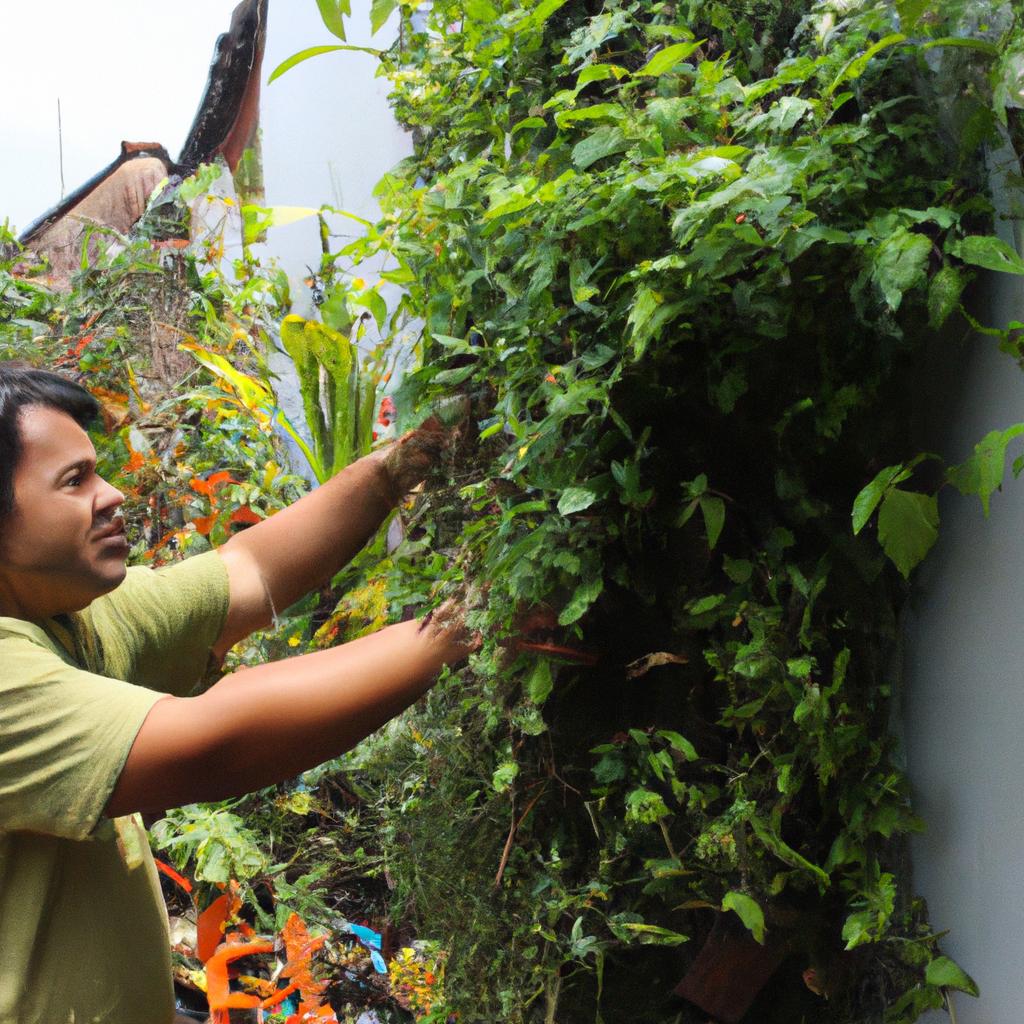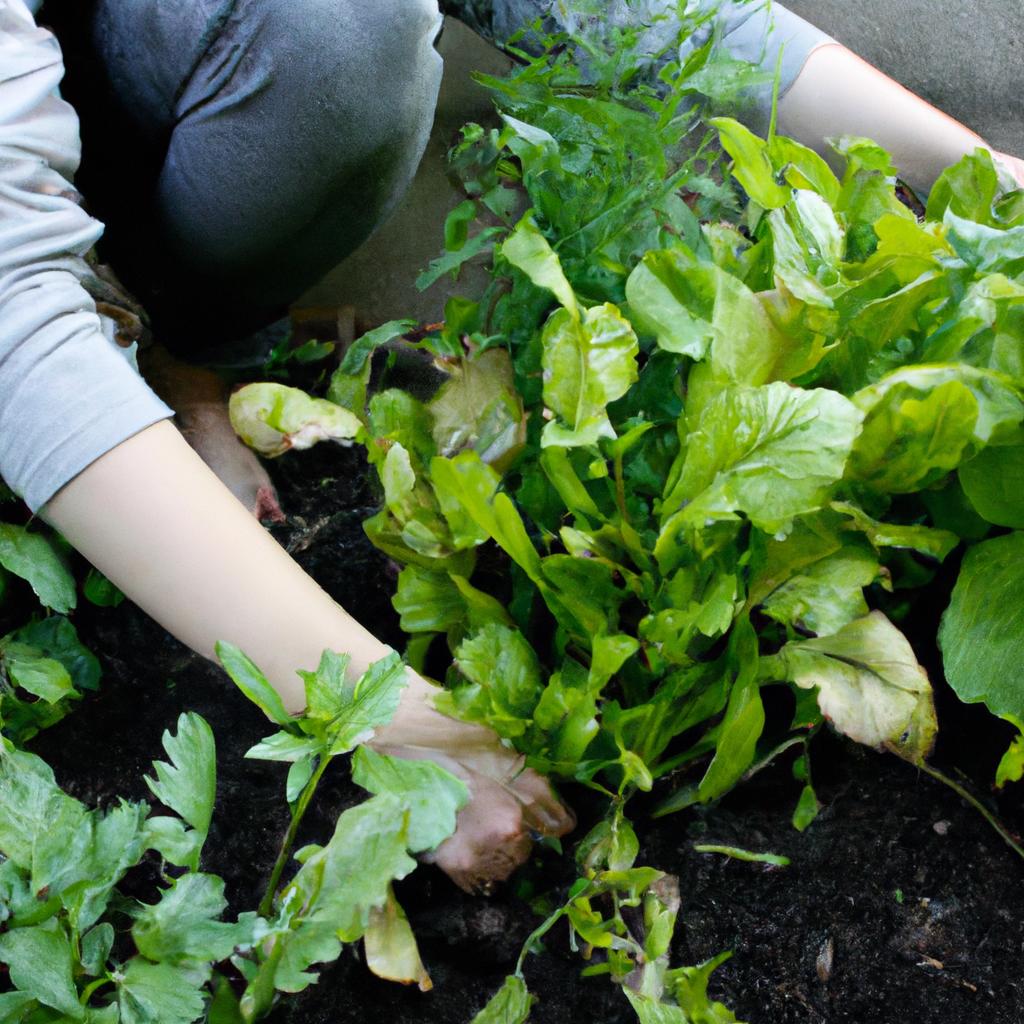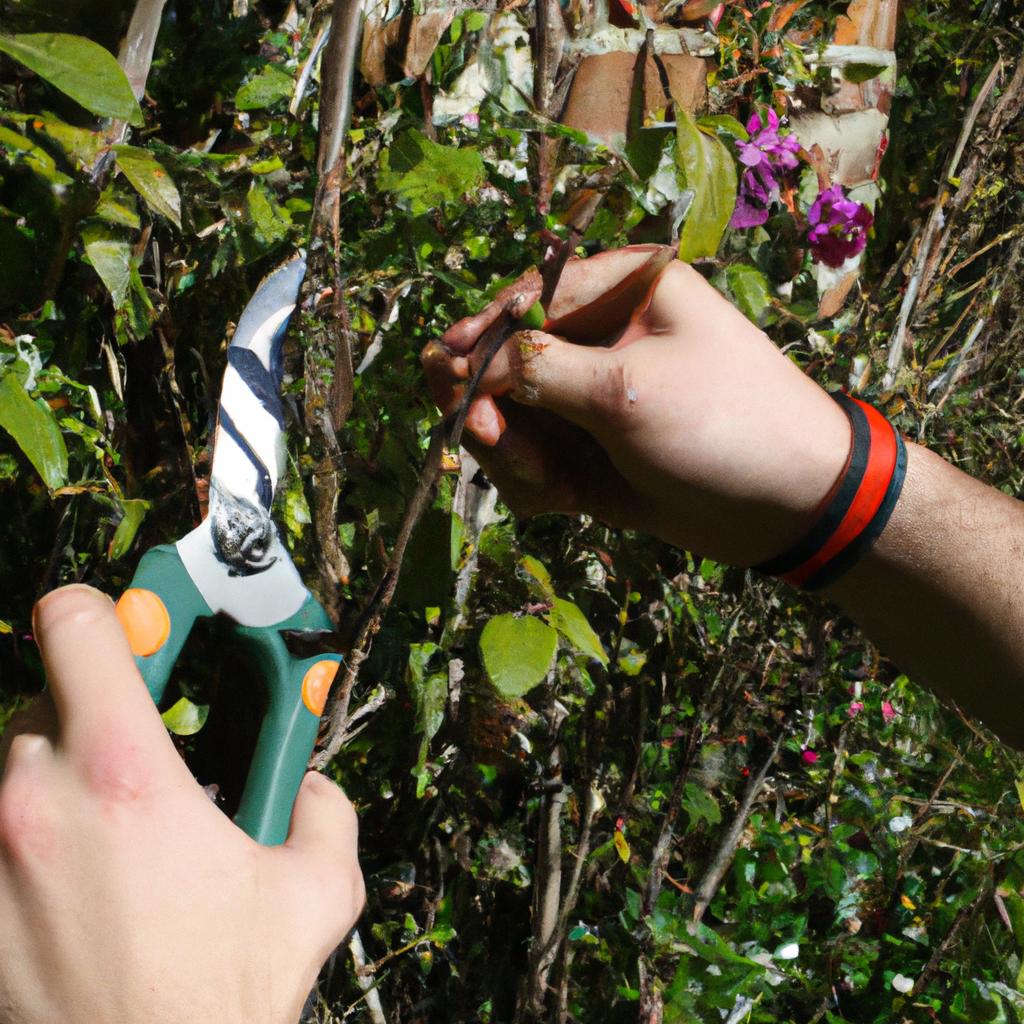Soil is an integral component of gardening, playing a crucial role in the growth and development of plants. Different types of soil possess unique characteristics that directly influence plant health and productivity. Understanding these various soil types is essential for garden enthusiasts seeking to create thriving recreational or food gardens. For instance, consider a hypothetical scenario where a gardener desires to cultivate vibrant flowers in their backyard but struggles with poor soil quality. By identifying the specific type of soil present and making informed choices based on its properties, this gardener can effectively amend the soil to meet the needs of their desired plants.
In order to navigate the vast array of soil options available for gardening purposes, it is important to have knowledge about different soil classifications. The primary categories include clay, sandy, loam, peat moss, silt, and chalky soils. Each type possesses distinct qualities such as texture, drainage capabilities, moisture retention capacity, nutrient content, acidity levels (pH), and overall fertility. These variations significantly impact how well plants can establish roots and access necessary nutrients for growth. Therefore, understanding these attributes enables gardeners to make informed decisions when selecting suitable crops or landscaping designs for optimal results in both recreation and food production settings.
Understanding Different Soil Types
Imagine you are an avid gardener, eager to turn a patch of land into a thriving oasis of plants and flowers. As you dig your shovel into the ground, you notice that the soil feels different—loose, gritty, or perhaps even sticky. This variation in texture is just one aspect of the diverse world of soils for gardening.
Soil types vary greatly depending on their composition and properties. Four main categories exist: sandy soil, clayey soil, loamy soil, and silt soil. Each type comes with its own set of characteristics that can significantly impact plant growth and overall garden success.
To better comprehend these different soil types, let’s explore them individually:
-
Sandy Soil:
- Consists mainly of large particles
- Drains water quickly
- Allows air circulation easily
- Requires frequent watering due to low moisture retention
-
Clayey Soil:
- Comprises small particles closely packed together
- Retains water well but drains slowly
- Can become compacted easily when wet
- Benefits from regular addition of organic matter to improve drainage
-
Loamy Soil:
- A balanced combination of sand, silt, and clay particles
- Provides good drainage while retaining adequate moisture
- Rich in essential nutrients for plants’ healthy growth
- Ideal for most types of gardening endeavors
-
Silt Soil:
- Contains fine particles similar to flour or powder
- Feels smooth and silky to touch when dry; becomes slippery when wet
- Holds moisture better than sandy soil but not as well as clayey soil
- Prone to erosion if left exposed without vegetation cover
Understanding the characteristics associated with each type allows gardeners like yourself to make informed decisions about which type suits their specific needs best. In the subsequent section on “Sandy Soil: Characteristics and Uses,” we will delve deeper into the features and applications of this particular soil type.
Sandy Soil: Characteristics and Uses
Understanding Different Soil Types is crucial for successful gardening. In this section, we will explore the characteristics and uses of sandy soil, which is one of the most commonly encountered soil types in gardens.
Let’s consider an example: imagine a garden located near a coastal area where sandy soil prevails. The owner wishes to grow vegetables but faces challenges due to the unique properties of sandy soil. By understanding these characteristics, they can make informed decisions to improve their gardening experience.
Sandy soil has distinct features that affect its suitability for various plants and cultivation methods:
- Drainage: Sandy soil drains quickly, preventing waterlogging and reducing the risk of root rot.
- Aeration: Its loose structure allows air circulation around plant roots, promoting healthy growth.
- Nutrient leaching: However, nutrients tend to leach out faster from sandy soils due to rapid drainage, requiring regular fertilizer application.
- Drought-prone: Sandy soil struggles with retaining moisture, making it more susceptible to drought stress. Adequate watering techniques become vital here.
To better grasp the implications of using sandy soil in gardening, let’s reflect on some emotional points through a bullet-point list:
- Easy weed control due to loose texture
- Frustration when dealing with nutrient deficiencies
- Satisfaction when successfully growing crops adapted to sandy soils
- Concerns about frequent irrigation requirements
Furthermore, below is a table summarizing key aspects related to sandy soil:
| Aspect | Description | Emotional Response |
|---|---|---|
| Drainage | Rapid draining helps prevent waterlogged conditions | Relief |
| Nutrient Leaching | Quick nutrient depletion requires frequent fertilization | Frustration |
| Drought Tolerance | Struggles with moisture retention during dry periods | Concern |
| Weed Control | Loose structure aids in easy removal of weeds | Contentment |
Now that we have explored the characteristics and emotional aspects of sandy soil, we can delve into the properties and challenges posed by clay soil in the subsequent section. Understanding these different soil types will equip gardeners to make informed decisions when cultivating their plants.
Clay Soil: Properties and Challenges
Moving on from sandy soil, let us now delve into the properties and challenges associated with clay soil. To better understand its characteristics, consider a hypothetical scenario where a gardener decides to grow vegetables in their backyard garden that contains predominantly clay soil.
Clay soil is known for its fine texture and high water-holding capacity. These qualities can be advantageous for plants during periods of drought as the moisture retained by the clay helps sustain growth. However, this also means that excess water may become trapped within the compacted particles of clay, leading to poor drainage and potentially causing root rot or other water-related issues for plants.
When it comes to working with clay soil, certain challenges should be taken into account. Firstly, due to its dense nature, clay soil tends to become easily compacted when walked on or exposed to heavy machinery. This compaction restricts root penetration and limits air circulation, which can hinder plant development. Additionally, because of its small particle size, clay soil has difficulty allowing nutrients and oxygen to move freely through it.
- Clay soil has excellent water retention capabilities but can suffer from poor drainage.
- Its dense nature makes it prone to compaction, limiting root growth.
- The small particle size hampers nutrient and oxygen movement within the soil.
- Regular amendments such as organic matter are beneficial for improving its structure.
Let’s further explore these aspects using a table:
| Properties | Advantages | Disadvantages |
|---|---|---|
| Water Retention | Helps sustain plant growth | Poor drainage potential |
| Compaction | Reduces weed emergence | Restricts root penetration |
| Nutrient Flow | Prevents leaching | Hampers nutrient uptake |
| Organic Matter | Improves soil structure | Requires regular additions |
Considering the challenges posed by clay soil, it is crucial to implement strategies that enhance its overall condition. Amendments such as adding organic matter like compost or aged manure can help improve its structure and drainage capabilities. By addressing these concerns, gardeners can create an environment conducive to plant growth in clay soil.
Transitioning into the subsequent section about “Loamy Soil: Ideal for Plant Growth,” we shift our focus from the challenges of clay soil to exploring a highly desirable type of soil renowned for supporting healthy vegetation without explicitly signaling a new step.
Loamy Soil: Ideal for Plant Growth
In the previous section, we explored the properties and challenges of clay soil. Now, let’s shift our focus to loamy soil, which is considered ideal for plant growth due to its unique characteristics. To illustrate how beneficial loamy soil can be, imagine a backyard vegetable garden flourishing with vibrant tomatoes, crisp cucumbers, and succulent carrots.
Loamy soil is a balanced combination of sand, silt, and clay particles. This composition allows it to retain moisture while also providing adequate drainage. As a result, plants grown in loamy soil have access to essential nutrients and water without becoming waterlogged or deprived of oxygen.
To further understand why loamy soil is so highly regarded by gardeners worldwide, consider the following benefits:
- Nutrient-rich: Loamy soil contains an optimal balance of organic matter that promotes healthy plant development.
- Easy cultivation: The loose structure of loamy soil makes it easy to work with when planting or transplanting crops.
- Versatility: This type of soil suits a wide range of plant varieties, making it suitable for both recreation and food production.
- Reduced erosion risk: Due to its cohesive nature, loamy soil helps prevent erosion caused by wind or heavy rainfall.
Let’s delve deeper into the advantages of using loamy soil through this table:
| Advantages of Loamy Soil |
|---|
| Retains moisture |
| Offers excellent nutrient retention |
| Prevents erosion risks |
As you can see from this table, loamy soil provides numerous advantages that contribute to successful gardening endeavors. From retaining moisture to facilitating root development and preventing erosion risks—loamy soil truly sets the stage for thriving vegetation.
With our exploration of loamy soil complete, let’s now transition to the subsequent section about peaty soil and its benefits and considerations.
Peaty Soil: Benefits and Considerations
Peaty soil, also known as boggy soil or mucky soil, is characterized by its high organic matter content. This type of soil forms in wet areas with poor drainage, such as marshes or swamps. One example of a plant that thrives in peaty soil is the carnivorous pitcher plant (Nepenthes spp.), which obtains nutrients from insects caught within its specialized leaves.
Peaty soil offers several advantages for gardening enthusiasts:
- Water retention: Due to its high organic matter content, peaty soil has excellent water-holding capacity. It retains moisture effectively, reducing the frequency of irrigation required for plants.
- Nutrient availability: The decomposition of organic matter in peat releases essential nutrients into the soil over time, providing a steady supply for plants’ growth and development.
- Acidity control: Peaty soil tends to be acidic due to the accumulation of decomposed plant material. For acid-loving plants like blueberries or rhododendrons, this natural acidity is advantageous.
However, there are certain considerations when working with peaty soil:
| Pros | Cons |
|---|---|
| – Good water retention | – Limited nutrient availability compared to loamy soils |
| – Natural acidity benefits acid-loving plants | – Compacted structure can impede root penetration |
| – Suitable for container gardening | – Can become compacted if not properly managed |
In conclusion, peaty soil’s ability to retain moisture and provide a continuous source of nutrients make it an attractive option for gardeners looking to cultivate specific types of plants. However, it is important to address potential challenges such as limited nutrient availability and compaction issues.
Transition Sentence: Moving on from considering the benefits and considerations of peaty soil, let’s now explore the characteristics and recommended methods for working with silt soil in gardening.
Silt Soil: Features and Best Practices
In the previous section, we explored the unique properties of peaty soil and its suitability for gardening purposes. Now, let us delve into another type of soil that holds significant importance in horticulture – silt soil. To illustrate the practical implications of silt soil, consider a hypothetical scenario where a gardener decides to cultivate a vibrant flower garden using this particular type of soil.
Silt soil is characterized by its fine texture and moderate drainage capabilities. Its ability to retain moisture makes it an ideal choice for cultivating water-loving plants such as irises or ferns. However, excessive moisture retention can also lead to poor aeration, making it necessary to incorporate organic matter or sand into the silt soil mixture to improve its structure and prevent compaction.
When working with silt soil, there are several considerations that gardeners should keep in mind:
- Nutrient Retention: Silt soils typically have good nutrient-holding capacity due to their high clay content. This characteristic allows plants to access essential elements required for healthy growth over an extended period.
- Erosion Risk: Due to its fine particles, silt soil is susceptible to erosion caused by wind or water runoff. Implementing proper land management practices such as contour plowing or mulching can help mitigate these risks.
- Permeability Issues: While silt soils hold moisture well, they may exhibit poor permeability when saturated. Adequate drainage systems should be established within gardens containing silt soil to prevent excess water accumulation.
- Fertility Management: Regular monitoring of nutrient levels is crucial when working with silt soils since their fertility can vary significantly based on location and agricultural history.
| Soil Type | Texture | Drainage Capability |
|---|---|---|
| Peaty Soil | Loose | High |
| Silt Soil | Fine | Moderate to Good |
| Sandy Soil | Coarse | Rapid |
| Clay Soil | Compact | Poor |
This table provides a concise overview of the texture and drainage capabilities associated with various soil types. Understanding these factors can assist gardeners in making informed decisions regarding appropriate plant selection and cultivation techniques.
In summary, silt soil offers unique benefits for gardening purposes due to its fine texture and moderate drainage capacity. However, proper management practices should be implemented to ensure optimal fertility levels and prevent erosion or waterlogging issues. By considering the specific characteristics of different soils, gardeners can create thriving gardens that cater to their recreational and food-related needs.
 Refoksa
Refoksa



